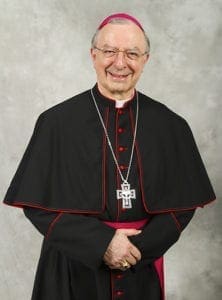The spirit of Epiphany
By BISHOP JOEL M. KONZEN, SM | Published January 7, 2021 | En Español
The Catholic Church has liturgical celebrations of events in the life of Jesus—Nativity, Epiphany, Baptism, Presentation, Transfiguration, Palm Sunday and the Passion, Resurrection, Ascension—and observances that celebrate a particular feature of his nature or activity, such as Trinity Sunday, Corpus Christi, the Sacred Heart of Jesus, Exaltation of the Holy Cross, and Christ the King.

Bishop Joel M. Konzen, SM
In this period which we say brings to a conclusion the season of Christmas, two of the liturgies that mark events in the life of Our Lord occur on successive Sundays: Epiphany on the first Sunday after Jan. 1, and the Baptism of the Lord on the following Sunday (or, if Epiphany is celebrated on Sunday, Jan. 7 or 8, the Baptism will be observed the next day, on Monday). And in between the Solemnity of Christmas and that of Epiphany, we have, on Jan. 1, the Solemnity of Mary, the Mother of God. It is by Mary, “the holy earth from which he was formed as man,” as Pope Benedict XVI has said, that “Christ forever remains in union with the earth.” Indeed, we are coming to the last days of a season rich in liturgical and theological treasures.
It may be that this year, especially, people are reluctant to put away the reminders of these profound realities of our faith. They bring a familiarity and comfort for us who, seeing just a symbol of one of these aspects of the life of our Savior, subconsciously review and replay the story of his coming among us and his legacy of the gift of salvation. A candle, a star, a dove—any of these might allow one to ponder the significance that such a symbol bespeaks.
Let us zero in for just a bit on one of these: the Solemnity of Epiphany (traditionally on Jan. 6, the 12th day of Christmas). In the Roman Church we have come to associate this celebration with the adoration of the newborn Jesus by the visitors “from the East”—Magi or Wise Men. It is something of an oversimplification, but we might think of them as one thinks of advisors to a head of state. They were consulted on matters of importance.
Like so much else that Jesus embodies and accomplishes, these individuals (three of them, according to tradition) represent a kind of contradiction. They are outsiders, Gentiles, who have come to worship the long-awaited Messiah of Jewish expectation, and they bear gifts that, Scott Hahn tells us, in “Joy to the World,” are fitting for a king (gold), a human (myrrh), and God (incense), but are also elements of the temple worship of Israel. Hence, their arrival seems to say that Jesus will realize the hopes of the people of Israel as he replaces the idol worship of neighboring lands with faith in the Holy One of Israel.
This account of those who followed the star and brought gifts to the infant Messiah was particularly cherished by those who converted to Christianity from pagan traditions. Hahn says, “It signals the salvation of the whole world and the restoration of the cosmic order…God had extended joy to the world, and the world responded with worship and celebration.” These Magi, the counselors, astrologers, were returning the gifts that God had given to the world by giving them to the One they could now recognize as God.
The spirit of Epiphany is the spirit of Psalm 116: “What return can I make to the Lord for all his goodness to me?” At the close of the Christmas season, we meditate on the life and the deeds of our Lord, and we set about once more to make some return with our lives, an offering of gratitude.